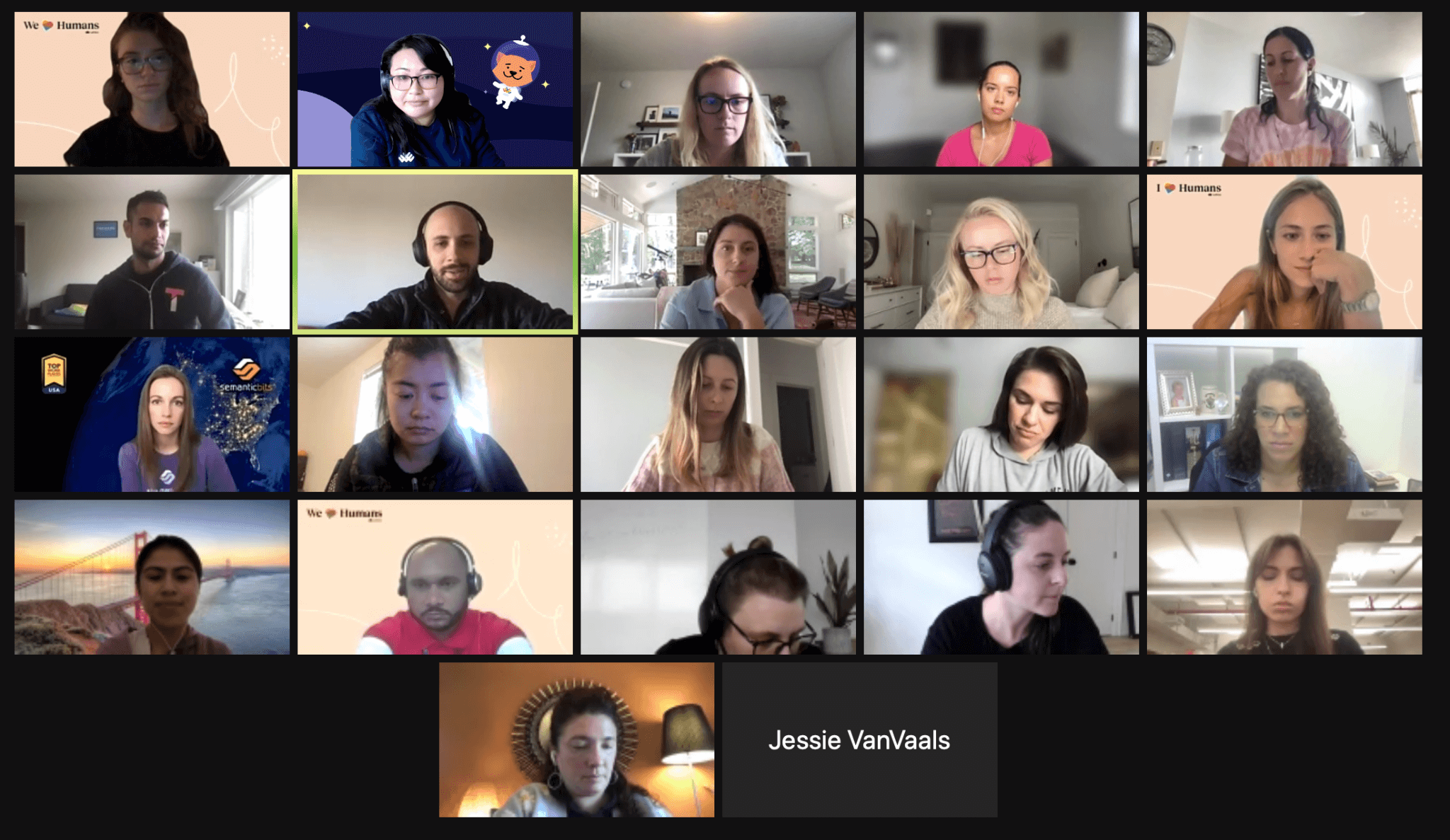Every successful company knows that retaining talent is critical. But, whether it's simply pandemic burnout, new opportunities, or just a re-evaluation of their career, employees are starting to consider their options.
Whether you call it the “turnover tsunami” or the “great resignation,” employee retention is a growing challenge for HR teams, who have been tasked with updating retention strategies to keep up with the new world of work.
Even for the most seasoned HR professional, this is no easy feat. Resources for Humans (RfH) — a Slack community of over 12,000 HR leaders — recently hosted a virtual working session for members to discuss how companies can get ahead of high turnover rates. Here are some of the session’s key takeaways:
1. Rethink your compensation strategy.
Compensation is just one part of your overall strategy for keeping teams motivated and high performing, but surveys show that employees rank it very high. As the current job market continues to fluctuate, HR teams have to remain flexible with changing market expectations for both hiring and retaining talent.
“We just did an engagement survey and I think one of the big things that came from that is there's a lot of burnout. There are a lot of employees feeling underpaid...people are finding other roles where they're being compensated better and they jumped ship,” said Aubrey Willis, People Operations Manager at ConsejoSano.
As compensation standards change, businesses will need to rethink and re-examine their compensation strategy in order to retain top performers. Not only will your future employees be more confident about joining your workforce, but your current employees will be more likely to stick with the business, even if it means starting from scratch.
“We're going through a compensation audit right now...so that's a three-month audit that's going to look at base salaries compared to the market. It's going to look at places where there's potential inequity. It's going to look at stock options and at vacation,” said Nathan Olson, Head of People and Operations at GetThru. “It's like we're doing a listening tour with the staff...It's really about signaling a commitment that we care about this,” he said.
Some businesses have decided to allocate part of their compensation budget specifically for retaining top performers.
“We created a retention plan where we tried to understand who our high potential or key talent employees are, and tried to make sure that they are compensated at least at the 75th percentile, for example, by just allowing a bit of extra budget for them and for retention bonuses,” said one RfH member.
2. Invest in culture.
Strong businesses usually have a strong company culture. Companies with supportive leadership and communities rarely have trouble finding and retaining talented employees. But building a strong culture in the new world of work is a daunting task, especially in the midst of a global pandemic. Luckily, there’s a lot HR teams can do to help foster connections between remote employees.
“I think a lot of people are looking for opportunities for points of connection...We started using Donut, and a lot of our employees are really enjoying that. On top of utilizing Donut, we say that you can expense lunch as part of it. So, it's kind of like you're grabbing lunch with a coworker – and gives them an added incentive to participate,” said Jenny Bard, Head of Human Resources at LiveAuctioneers.
Connection is at the root of company culture. So when companies create opportunities for employees to connect and form meaningful relationships across the organization, they’re able to retain more employees in the long run.
“We have a buddy system. We have one local buddy for the person, and then we also have a global buddy, and a third buddy that's in a different department, just to give that one person that's starting alone and doesn't have that cohort a little bit more interaction with people both around the world and in different departments,” said Jessie VanVaals, Human Resources Manager at Okane Consultants.
After all, fostering a strong culture breeds psychological safety in the workplace. When employees feel safe to express their opinions, they’re more likely to be motivated, confident, and productive (and less likely to want to leave).
“The amount of stress that people have been experiencing in the last 12 months or longer — it’s generally a little bit higher [now], and that means people are more sensitive to things like surprises. Surprises are not great for stress. So transparency is a really, really big driver for feeling comfortable and safe at work,” said Liz Willette, VP Human Resources at PerformLine. “If you don't feel grounded and safe in the work environment, that's a very key psychological play for people when they are open to looking,” she said.
3. Show your appreciation.
The ups and downs of the pandemic are not over, and employees may be feeling burnt out or uncertain about the future. HR teams can keep people motivated by ensuring employees feel recognized, heard, and appreciated while they continue to work from home.
“We are refreshing some of our benefits-related policies around wellness, home office equipment, and professional development...Part of that approach was to step back and think about ways that we can give employees more flexibility, more decision-making, and manage things like their wellness benefits,” said Olson. “It used to be that you can use [your stipend] for things like gym memberships and yoga classes, and we expanded that definition to anything that makes you feel well, physically, mentally, spiritually. We moved from a monthly stipend to an annual stipend,” he said.
In remote and hybrid workplaces, many HR teams are getting creative about using technology to acknowledge and reward employees.
“[We implemented] Blueboard as a platform for engagement recognition. It's basically giving people bonuses not in the form of cash but experiences. I have to say I was a little bit skeptical of it at first, but seeing the adoption and also how much the team advocated for it, I think it was a really good thing to do,” said Dan Smolkin, Head of People Ops at Aurora Solar.
Sometimes, showing employees that you care about them requires breaking with convention. Just because something hasn’t been done before, doesn’t mean that it can’t or shouldn’t be done – especially if it means holding on to valuable talent.
“We did a sabbatical for someone specifically who was pretty ready to churn. We had never done sabbaticals previously, and he recently came back and has been one of our most productive employees,” said an RfH member.
4. Prioritize career development.
Investing in employee development helps your employees feel empowered and valued beyond their output. Not only does it allow them to expand their skill sets, but it also encourages them to stay committed to a company that is invested in their growth and long-term success. Part of this investment is providing clear and flexible opportunities for growth within the organization. Instead of locking employees into a career ladder, consider building a career lattice based on their own short and long term goals.
“There's a lot of talk about changing the structure and the fundamental nature of work. As a progressive company, it's something we want to try and be ahead of. And I don't want to lose sight of that as we enter this new phase of the pandemic,” said Olson.
HR teams’ biggest partners in fostering internal growth are managers. Managers are the main facilitators of career development conversations and developmental reviews, so businesses should both rely on and enable them to build loyalty amongst employees.
“It's so crucial to have the right managers in place who are not just delegating work and making sure that people are delivering, but also seeing them as humans, really caring about their professional development, and regularly having conversations with them to understand their motivations,” said Linda Deeb, VP of Talent & People at Finite State.
5. Listen to your employees.
You can learn a lot about your people just by listening. Losing employees, especially top performers, is costly for businesses and can deal a blow to team morale. Surveys can help businesses discover their employees’ needs and pain points, but HR teams also need to dig deeper to understand what is driving key employee decisions.
Beyond conducting a company or team-wide survey, RfH members also emphasized the importance of simply talking to people one-on-one. By being transparent and practicing active listening across departments, HR teams can learn a lot about how employees are feeling and what they think could be going better.
“The company felt like we were growing and there were too many layers in between people. So our VPs of each department do quarterly meetings with all their employees, and they try to set up one-on-one meetings with people that are identified as key talent to make sure that if there's something that we can do to improve their experience with the company, we are doing it,” said one RfH member.
__
HR professionals have the hard task of setting their companies’ retention and hiring strategies, but, luckily, they have a global community to learn from. Those are just some of the insights shared during a recent Resources for Humans virtual working session. If you haven’t already, join the over 12,000 HR leaders that make up our HR Slack community or subscribe to the I ♡ Humans newsletter.







